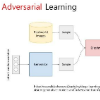The task of Knowledge Graph Completion (KGC) aims to automatically infer the missing fact information in Knowledge Graph (KG). In this paper, we take a new perspective that aims to leverage rich user-item interaction data (user interaction data for short) for improving the KGC task. Our work is inspired by the observation that many KG entities correspond to online items in application systems. However, the two kinds of data sources have very different intrinsic characteristics, and it is likely to hurt the original performance using simple fusion strategy. To address this challenge, we propose a novel adversarial learning approach by leveraging user interaction data for the KGC task. Our generator is isolated from user interaction data, and serves to improve the performance of the discriminator. The discriminator takes the learned useful information from user interaction data as input, and gradually enhances the evaluation capacity in order to identify the fake samples generated by the generator. To discover implicit entity preference of users, we design an elaborate collaborative learning algorithms based on graph neural networks, which will be jointly optimized with the discriminator. Such an approach is effective to alleviate the issues about data heterogeneity and semantic complexity for the KGC task. Extensive experiments on three real-world datasets have demonstrated the effectiveness of our approach on the KGC task.
翻译:知识图完成( KGC) 的任务旨在自动推断知识图( KG) 中缺失的事实信息 。 在本文中, 我们从新角度出发, 目的是利用丰富的用户项目互动数据( 用户互动数据, 简称) 来改进 KGC 任务。 我们的工作受到许多 KG 实体对应应用系统中在线项目的观察的启发。 但是, 两种数据源具有非常不同的内在特征, 并有可能通过简单的聚合战略损害初始性能。 为了应对这一挑战, 我们提出一种新的对抗性学习方法, 利用用户互动数据来完成 KGC 任务。 我们的生成器与用户互动数据隔绝, 用于改善歧视者的业绩。 歧视者将从用户互动数据中学到的有用信息作为输入, 并逐步加强评估能力, 以便识别生成器生成的假样本。 然而, 要发现用户对隐含的实体偏好, 我们根据图形神经网络设计一个复杂的协作学习算法, 与歧视者共同优化。 这种方法可以有效缓解数据高度遗传性和语系复杂度问题 。 KGC 所展示的真实任务 。 KGC 。

















